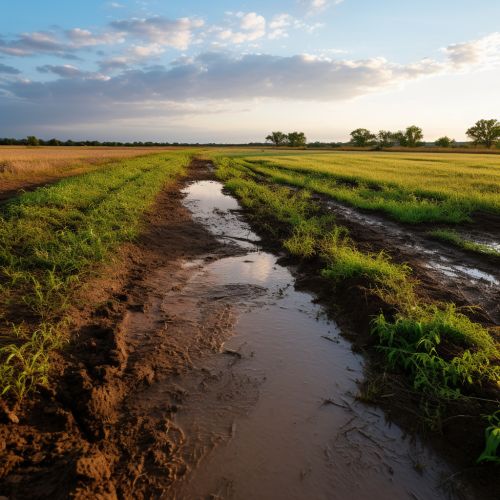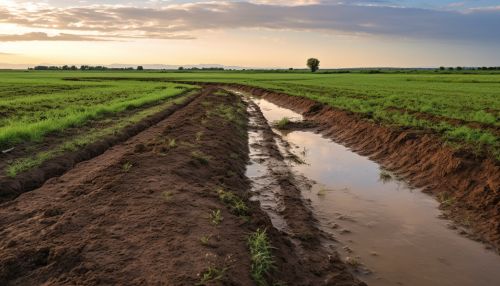Agricultural runoff
Overview
Agricultural runoff is a form of nonpoint source pollution that originates from the dispersal of fertilizers, pesticides, and other agrochemicals during rainfall events. As rainwater moves over and through the ground, it picks up and carries away natural and synthetic pollutants, depositing them into lakes, rivers, wetlands, coastal waters, and even underground sources of drinking water. Nonpoint source pollution, such as agricultural runoff, is a leading cause of water quality problems in many parts of the world.
Causes
The primary causes of agricultural runoff are the overuse and improper application of agricultural chemicals, as well as the mismanagement of animal waste. These substances can be carried by rainwater or irrigation water from the fields where they are applied into nearby water bodies.
Fertilizers
Fertilizers are a primary source of agricultural runoff. They are used to increase the productivity of agricultural land by supplying essential nutrients to the soil. However, when applied in excess or at inappropriate times, these nutrients can be washed away into nearby water bodies, causing a variety of environmental problems.
Pesticides
Pesticides are another significant source of agricultural runoff. These chemicals are used to control pests that can damage crops. However, like fertilizers, they can be washed away by rainwater or irrigation water, contaminating nearby water bodies.
Animal Waste
Animal waste, particularly from concentrated animal feeding operations (CAFOs), is a significant source of agricultural runoff. These operations produce large amounts of manure, which can contain nutrients, pathogens, and other pollutants. If not properly managed, these substances can be carried by rainwater or irrigation water into nearby water bodies.
Impacts
Agricultural runoff can have a variety of impacts on the environment and human health.
Eutrophication
One of the primary environmental impacts of agricultural runoff is eutrophication. This process occurs when excess nutrients, particularly nitrogen and phosphorus, enter a water body and cause a rapid increase in the growth of algae and other aquatic plants. When these plants die and decompose, they consume oxygen in the water, leading to low oxygen levels that can kill fish and other aquatic life. This process is known as eutrophication.
Human Health Impacts
Agricultural runoff can also have significant impacts on human health. For example, nitrates from fertilizers can contaminate drinking water sources, posing a risk to human health. High levels of nitrates in drinking water can cause methemoglobinemia, a condition that reduces the ability of blood to carry oxygen. Pesticides in runoff can also contaminate drinking water sources, posing a risk to human health.
Mitigation
There are several strategies for mitigating the impacts of agricultural runoff. These include the use of best management practices (BMPs), the implementation of conservation practices, and the use of precision agriculture technologies.
Best Management Practices
Best Management Practices (BMPs) are techniques or control measures used to manage the quantity and improve the quality of stormwater runoff. In the context of agriculture, BMPs can include practices such as nutrient management, integrated pest management, and conservation tillage.
Conservation Practices
Conservation practices, such as the establishment of riparian buffers and the implementation of cover cropping systems, can also help to reduce the impacts of agricultural runoff. Riparian buffers are areas of vegetation planted along the banks of water bodies to filter runoff and absorb excess nutrients. Cover crops are planted to protect the soil from erosion and to absorb excess nutrients.
Precision Agriculture
Precision agriculture is a farming management concept that uses information technology to ensure that crops and soil receive exactly what they need for optimum health and productivity. This approach can help to reduce the over-application of fertilizers and pesticides, thereby reducing the potential for agricultural runoff.
See Also
Categories


